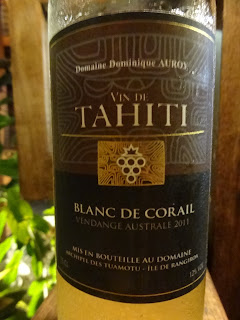 |
| I confess, I was sitting here when I could have been interviewing the winemaker. Sorry. |
The soil is salty. Sea water laps within a few meters of the vines, which are grown on a tiny island across a channel from Rangiroa, where scuba divers (like me) come to swim with dolphins, sharks and turtles.
The weather is unrelentingly hot. Storage is a problem because air conditioning is expensive. Every kind of supply -- even drinking water -- must be flown from Tahiti to the airport in Rangiroa, then brought over the channel by boat.
To add an extra degree of difficulty, the vines have tropical pests that have never been seen in vineyards anywhere in the world. One particularly voracious beetle couldn't even be identified by experts at the University of Montpellier.
Of the first 50 types of wine grapes Auroy tried to grow, only one survived: rugged Carignane, the workhorse grape of Algeria when the French occupied it. He still grows Carignane, a red grape, but Auroy eventually gave up on making red wine and today makes only two whites and a rosé.
One advantage of making wine in the tropics is that Auroy gets two harvests a year. And he does get to live on beautiful Rangiroa, although that limits his culinary options. At least the fresh fish is great.
I visited Auroy in 2005 when he was only able to make 800 bottles a year from both harvests combined. We walked through his vineyard and the vines looked as scrawny and sickly as any I've ever seen. His red wine wasn't very good, but his dry white -- made from Carignane, with the skins removed immediately -- was already nice.
I interviewed him at length in 2005, but I didn't have a blog then and I couldn't sell the story. US magazines weren't interested in a story about an expensive wine that you had to go to Tahiti to find.
Seven years is a long time and I couldn't find that notebook (though I did get a laugh when I found this one). What I have above are the facts I used to unsuccessfully pitch the story to editors. This year I decided not to spend a day in the tropical heat revisiting the winery on my recent diving vacation, but I did drink the wine and it has really improved, to the point where the 1900 francs that it costs duty-free (about $21 US) is good value. At one time it was slightly available in Los Angeles; I don't know if you can now easily buy it outside of French Polynesia. But I liked it a lot and brought home one bottle of each wine.
Vin de Tahiti Australe 2011 Blanc de Corail has a powerful tropical fruit aroma of pineapple and papaya. On the nose, you'd almost think it's fruit wine. But it's dry and refreshing, fruity, complex and unique. 12% alcohol. Highly recommended for a taste of truly unique terroir.
Follow me on Twitter: @wblakegray and like The Gray Report on Facebook.

No comments:
Post a Comment